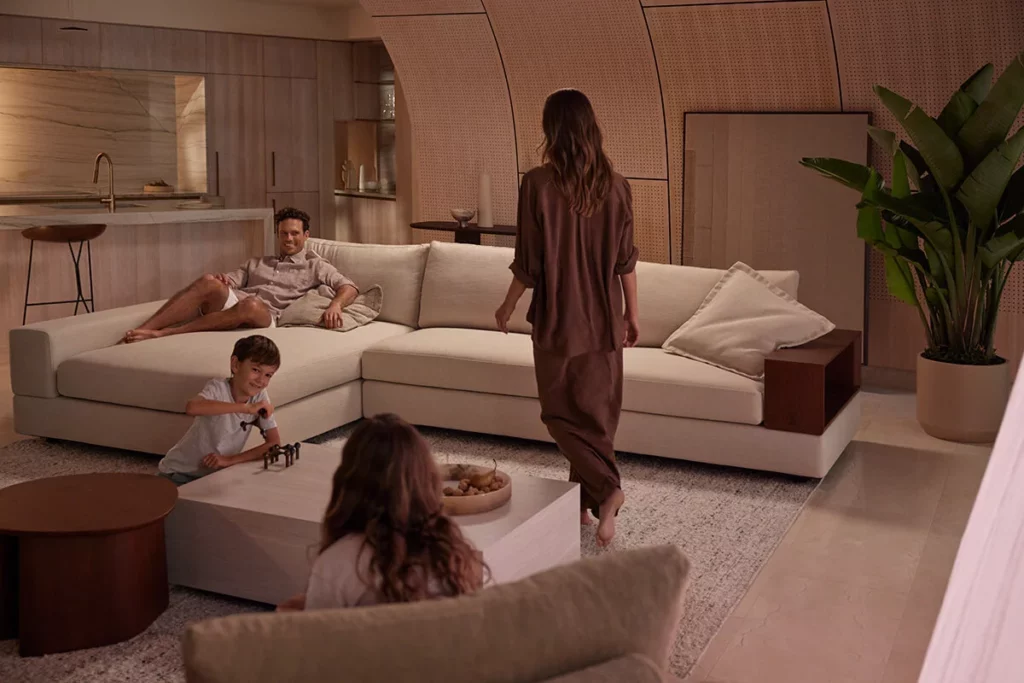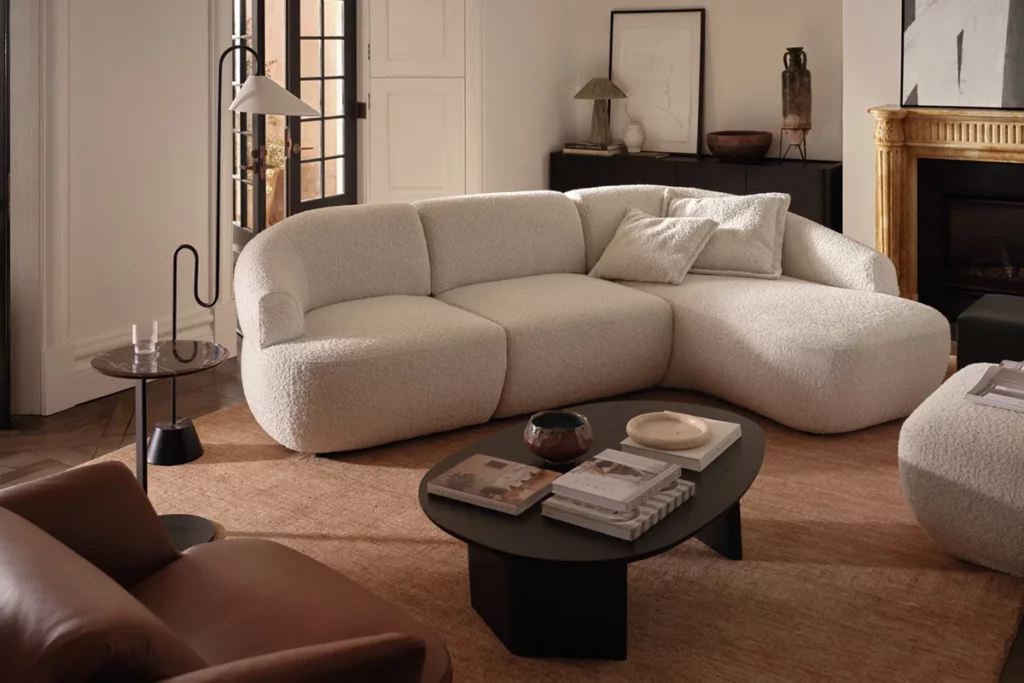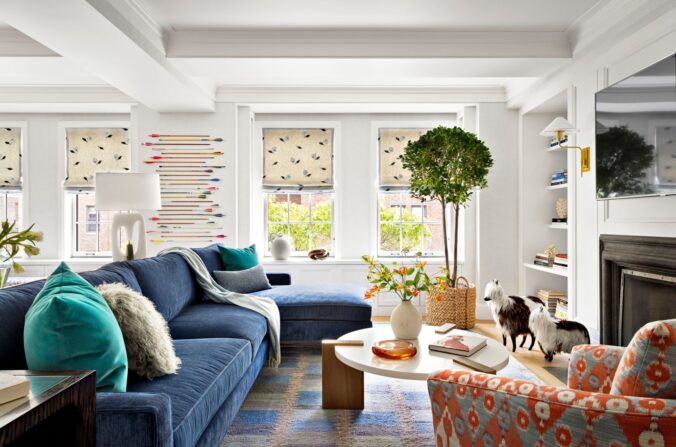How Can Modular Sofas Transform Your Living Room?
Modular sofas are changing the way we think about living spaces. They offer a level of flexibility that traditional sofas just can’t compete with. These innovative pieces of furniture are made up of individual sections that can be connected together, allowing you to create custom arrangements that perfectly fit your needs and the dimensions of your room.
The growing popularity of designer modular sofas is largely due to their ability to adapt to your lifestyle. Whether you’re hosting a big get-together, creating a cosy conversation area, or accommodating a growing family, these versatile pieces can be adjusted to meet your changing needs without the need to buy new furniture.
Here are some key benefits of using modular sofas:
- Adaptability: You can rearrange the sections whenever you want, whether it’s seasonally or whenever you feel inspired.
- Space optimisation: In compact or oddly shaped rooms, modular sofas help you make the most of every square metre.
- Personalised styling: You have the freedom to choose fabrics, colours, and configurations that reflect your unique style.
- Future-proofing: As your living situation changes, you can easily add or remove modules to accommodate those changes.
This approach to transforming your living room empowers homeowners to refresh their interiors simply by rearranging furniture instead of going through expensive renovations. It’s a smart investment for modern living where flexibility and adaptability are key.

1. What Makes Modular Sofas Adaptable and Flexible?
Modular sofas function as furniture building blocks that you can arrange and rearrange to match your changing needs. Each section—whether an armless chair, corner piece, or ottoman—connects seamlessly with others, creating countless modular sofa configurations that adapt to your lifestyle.
The beauty of adaptable sofas lies in their ability to evolve with you. When you host a dinner party, separate the modules into individual seats around the room. For film nights, push them together into a sprawling lounger. Expecting guests? Reconfigure the pieces into a guest bed arrangement. This flexible furniture layout approach means your investment continues serving different purposes year after year.
Unlike traditional sofas that lock you into one arrangement, modular pieces let you experiment with your space without financial commitment. Move a chaise from the left side to the right, swap corner sections to open up walkways, or remove modules entirely to create more floor space. The sections remain fully functional whether used together or independently.
This adaptability proves particularly valuable when life circumstances shift—moving house, welcoming a new baby, or simply craving a fresh aesthetic. Your modular sofa moves with you, fitting into different room dimensions and layouts. The modules that formed an L-shape in your previous flat might create a U-shaped conversation pit in your new home, all without purchasing additional furniture.
2. How Can Modular Sofas Help Zone Your Living Room?
Modular sofas excel at dividing open-plan spaces into distinct functional areas without the need for walls or permanent partitions. Strategic modular sofa arrangement allows you to separate your living room into dedicated zones—perhaps a conversation area facing a fireplace and a media zone oriented toward the television, or a reading nook distinct from the main seating cluster.
Zoning with sofas becomes particularly valuable in challenging room layouts:
- L-shaped living rooms benefit from corner modules that naturally define the seating boundary whilst maintaining visual connection across spaces
- Long, narrow rooms can be divided using a sofa positioned perpendicular to the longest wall, creating an intimate seating area at one end and leaving space for other activities beyond
- Open-plan living-dining areas work well with a sofa acting as a subtle room divider, with the back of the sofa facing the dining zone
- Large square rooms often feel cavernous with traditional furniture pushed against walls; floating modular sections in the centre creates cosy living room zones whilst preserving circulation space around the perimeter
Awkwardly shaped rooms with bay windows, alcoves, or angled walls pose difficulties for standard sofas. Modular sections adapt to these quirks—single chairs tuck into alcoves, whilst larger modules occupy the main floor area. This flexibility transforms problematic architectural features into design opportunities rather than obstacles.
3. How Do Modular Sofas Make the Most of Space?
Modular sofas maximize every square metre by allowing you to arrange sections that fit your room’s exact size while still leaving clear paths for movement. Unlike fixed sofas that leave awkward gaps or block natural furniture routes, individual modules can be positioned to create generous seating without blocking walkways—this is crucial for making the most of space in smaller homes.
Smart positioning changes tricky layouts:
- Wall-hugging configurations work brilliantly in small living rooms, where pushing modules against perimeter walls frees up central floor space and creates an open, breathable atmosphere. This aligns well with how to arrange furniture for optimal space usage.
- Peninsula arrangements extend from one wall into the room, providing ample seating whilst defining boundaries without solid barriers.
- Back-to-back positioning in open-plan spaces uses the sofa as a room divider, separating living and dining zones whilst maximising seating on both sides.
The beauty of these ideas lies in their ability to adapt to narrow, long, or L-shaped spaces where traditional three-seaters simply won’t work. A three-module arrangement along a long wall can accommodate more people than a standard sofa whilst keeping the centre of the room clear for circulation.
Corners become valuable real estate rather than wasted space when corner modules slot seamlessly into 90-degree angles, creating cosy conversation nooks that would otherwise remain empty. These arrangements are particularly useful in scenarios like when the front door opens directly into the living room, or when trying to fill awkward spaces in a living room.
4. What Customisation Options Are Available for Modular Sofas?
Sofa customisation transforms a standard piece into a perfectly tailored centrepiece that reflects your personal style. Modular sofas offer extensive personalisation options that let you design exactly what your living room needs.
Fabric Options
Fabric options represent the most visible customisation choice, with materials ranging from luxurious velvet and durable linen to easy-clean performance fabrics. Colour palettes span neutral tones for timeless appeal or bold hues that make a statement. Texture selection adds another dimension—smooth leather creates sophistication whilst woven fabrics bring warmth and casual comfort.
Leg Styles
Leg styles might seem minor but dramatically affect the overall aesthetic:
- Wooden legs in oak, walnut, or painted finishes suit traditional or Scandi-inspired spaces
- Metal legs in brass, chrome, or matte black complement contemporary interiors
- Low-profile or hidden bases create a floating appearance ideal for minimalist designs
Additional Features
Additional features expand functionality beyond basic seating. Chaise lounge modules provide stretched-out relaxation zones, whilst recliner sections add cinema-style comfort. Some modular systems include adjustable headrests, built-in USB charging ports, or convertible armrests that double as side tables.
The beauty of modular design means you can start with essential pieces and add specialised modules later as your budget or needs evolve, creating a truly bespoke seating solution.
5. How Can Modular Sofas Serve Multiple Functions?
Multi-functional sofas transform compact living rooms by combining seating with practical storage solutions. Many modular designs feature hidden storage compartments beneath seat cushions or within armrests, perfect for stashing blankets, magazines, remote controls, and children’s toys without cluttering your space.
These versatile pieces address the challenge of limited square footage in urban flats and smaller homes. A modular section that doubles as a storage unit eliminates the need for separate cabinets or ottomans, freeing up valuable floor space whilst keeping essentials within arm’s reach.
Beyond storage, modular sofas can incorporate sleeper sections that convert into guest beds—ideal for hosting overnight visitors without dedicating an entire room to occasional use. Some designs include adjustable backrests that shift from upright seating positions to reclined lounging angles, adapting to different activities throughout the day.
The modularity itself adds functionality, as individual sections can serve as standalone seats when hosting larger gatherings. Pull apart your L-shaped configuration to create separate seating clusters during parties, then reassemble it for everyday family use. This flexibility proves particularly valuable in studio apartments or multi-purpose rooms where furniture must adapt to various scenarios, from working from home to entertaining friends or relaxing with family movie nights.
6. What Styling Tips Enhance The Look Of Modular Sofas?
Styling modular sofas effectively starts with selecting the right accessories to create visual cohesion. Layer cushions in varying sizes and textures—mix solid colours with patterns that complement your sofa fabric whilst keeping to a consistent colour palette of three to four shades maximum.
Area rugs anchor modular arrangements and define seating zones within larger spaces. Choose a rug large enough that all front legs of your sofa modules sit comfortably on it, creating a unified seating area that feels intentional rather than scattered.
Side tables and coffee tables should match the scale of your modular configuration. For L-shaped arrangements, a round or oval coffee table softens angular lines, whilst rectangular tables work well with straight sectional layouts. Keep table heights consistent with seat cushions for comfortable reach.
Throws draped casually over one section add warmth and invite relaxation. Select materials that contrast with your upholstery—a chunky knit throw pairs beautifully with smooth leather, whilst linen complements velvet textures.
Wall art and lighting complete the styling picture. Position artwork at eye level when seated, and use floor lamps or pendant lights to illuminate reading corners created by individual modules. These clever modular sofa ideas to customise and refresh your living room transform functional furniture into a designer-worthy focal point that reflects your personal aesthetic.
7. What Practical Considerations Should Be Made When Choosing Modular Sofas?
Measure doorways, hallways, and staircases before purchasing any modular pieces. Individual modules must navigate these spaces during delivery and future rearrangements. Standard doorways typically measure 76cm wide, so verify each section’s dimensions against your home’s access points to avoid delivery-day disappointments.
Fabric durability becomes paramount for busy households. Performance fabrics with high rub counts (above 25,000 Martindale) resist wear from daily use, whilst stain-resistant treatments protect against spills. Leather and microfibre options offer easy cleaning for homes with pets or children, though tightly woven textiles also provide excellent resilience.

Key practical sofa tips for selection:
- Test comfort thoroughly – sit on modules both individually and when connected, as some configurations may create uncomfortable seams
- Check connection mechanisms – secure clips or brackets prevent sections from separating during use
- Consider weight – lighter modules allow easier rearrangement, whilst heavier pieces offer stability
- Verify warranty coverage – quality manufacturers provide extended guarantees on frames and mechanisms
- Assess cushion density – high-density foam (35kg/m³ or higher) maintains shape longer than softer alternatives
The depth of seat cushions affects both comfort and room proportions. Deeper seats (beyond 60cm) suit lounging but consume more floor space, whilst shallower options work better in compact rooms. Removable, washable covers add practicality for maintaining freshness throughout the sofa’s lifespan.
How Can Changing Modular Sofa Configurations Refresh A Living Room?
Modular sofa reconfiguration offers an instant room makeover without the expense or disruption of major renovations. Simply rearranging your existing modules transforms the entire feel of your space, making it one of the most cost-effective ways to update your home.
Switching from an L-shaped arrangement to separate seating clusters creates a more conversational atmosphere perfect for entertaining. Alternatively, converting a straight sofa into a U-shape configuration adds extra seating capacity when hosting guests. Adding or repositioning a chaise module introduces a relaxed lounging zone that changes the room’s functionality entirely.
Refreshing living room layout becomes effortless when you experiment with different configurations seasonally. A cosy corner arrangement works beautifully for winter evenings, whilst an open, airy setup suits summer gatherings. This flexibility means your living space evolves alongside your lifestyle needs.
The beauty of clever modular sofa ideas to customise and refresh your living room lies in their simplicity—no contractors, no major purchases, just creative rearrangement that breathes new life into your existing furniture investment.
Related : Expert Tips for Choosing Long-Lasting Pieces from a Furniture Warehouse
FAQ’s on Modular Sofa Ideas
Modular sofas are made of individual sections (like corner units, armless chairs, ottomans, and chaises) that can be arranged in various configurations. Each piece connects seamlessly with others, allowing you to design a layout that fits your space, needs, and style preferences. Their flexibility makes them ideal for modern, dynamic living spaces.
Modular sofas are designed to grow with you. Whether you move homes, host guests, start a family, or want a new look, modular pieces can be added, removed, or rearranged to suit your current situation—without needing to buy a new sofa. They’re a practical, future-proof investment.
Yes. Modular sofas are excellent tools for zoning open-plan spaces. Use them to subtly divide living and dining areas, create a reading nook, or define a media zone. Strategic placement—like using the back of a sofa to separate spaces—can replace the need for partitions or walls.
In smaller rooms or homes with unusual layouts, modular sofas make the most of available space. You can fit pieces into corners, arrange them along walls, or float them in the centre of the room without wasting square footage. This tailored fit helps maximize seating while maintaining flow.
Customisation includes fabric (velvet, linen, leather, performance textiles), colour, leg style (wood, metal, low-profile), and added features like recliners, storage, or USB ports. You can build your ideal configuration from the ground up or start small and add modules over time.
Absolutely. Many designs include hidden storage, sleeper modules for guests, and convertible components that serve as beds or loungers. This is especially useful in smaller homes or studios where every piece of furniture needs to serve multiple purposes.
Use layered cushions in complementary colours and textures, a rug to anchor the arrangement, and scaled side tables to enhance both function and aesthetics. Throws, lighting, and wall art can further personalise the space while unifying your modular layout
Measure your doorways and access points, check fabric durability, and test comfort and connection mechanisms. Opt for high-density cushions and performance fabrics if durability is a priority. Removable covers and warranties add long-term value and practicality.
Yes—rearranging modular pieces is a cost-effective way to refresh your space. Switch from an L-shape to a U-shape, add a chaise, or break the setup into individual chairs. This allows you to change the room’s function or vibe without spending on new furniture.
Modular sofas are built for longevity, adaptability, and evolving needs. Unlike fixed sofas, they grow with your lifestyle, support design flexibility, and can be updated piece by piece. They’re ideal for homeowners looking for both practicality and design freedom over time.
